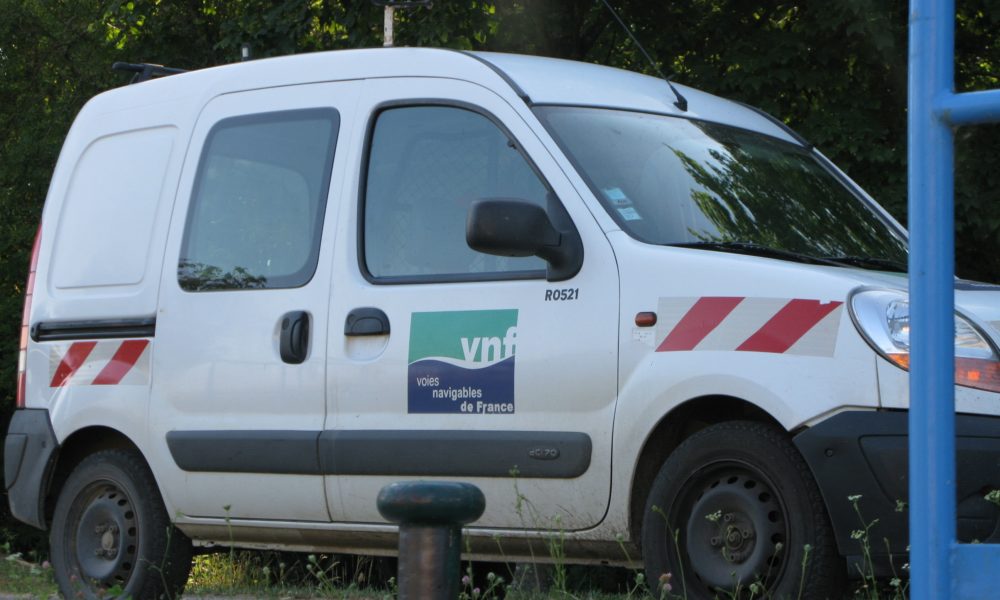
Help us out, we want out of the locks!
47° 27′ 41.8392” N 5° 22′ 19.6932” E
July 15, 2015
We are starting to get tired of the locks. We cannot bear any more of them. We have done more than a hundred locks since we started the holiday one and a half weeks ago. Now enough is enough.
The only sure cure for this is to sail out of the channel, and we still have 28 locks in front of us before we are done with Canal entre Champagne et Bourgogne and can sail into the river Saone. So we carry on with the locks again today.
The locks are close to one another at this side of the mountain. In turn, the weather has been a challenge. More than 30 degree celsius already at the end of the morning, we are confident. We therefor start early. Before eight o’clock. It gives us some cool hours, where everything works. But then we come to sail behind a peniche. And we are in a series of locks under remote control.
We call again and again to VNF. “Parles vour anglais?” We ask hopefully. “Pas du tout” is the response almost every time. And then we have the trouble. Per embarks on his through the winter updated French: “Ici batoux plaisance Ronja. Avalant (declining). Nous sommes a ecluse numero 32. The shit does not work. The lock is red, and not a damn thing is happening, when we use our remote control. ”
Amazing what you learn at evening-classes at FOF in Odense (running french-lessons) even without excessive diligence with homework.
VNF come and fix the error within 20 minutes. Only a very few times we have to make an additional call.
A place to moor for the night we find a kilometre after lock 35, Beaumont. We put Ronja under a grain silo. Only ship at the spot. No other boats have ventured to sail as far forward in the lock system this day.
Let’s get out of the locks. Tomorrow we have nine locks back, then there will be free passage down the Saone River, where we expect the city Auxonne to be the first stop for more than just one night. From there the rest of the tour will be 14 days with only 16 locks between us and the Mediterranean. Great.
Log book: Today’s distance: 33 km. Sailed time 7:45 to 18:00 = 10 ¼ hour. Locks: 20 !!! Weather: Sun all day. Possibly 35 degrees. We have no thermometer. But clearly one of the hottest days at all. We rig a large umbrella to create shade for the helmsman. Comfortable on the straights. A hassle during the lock operations.
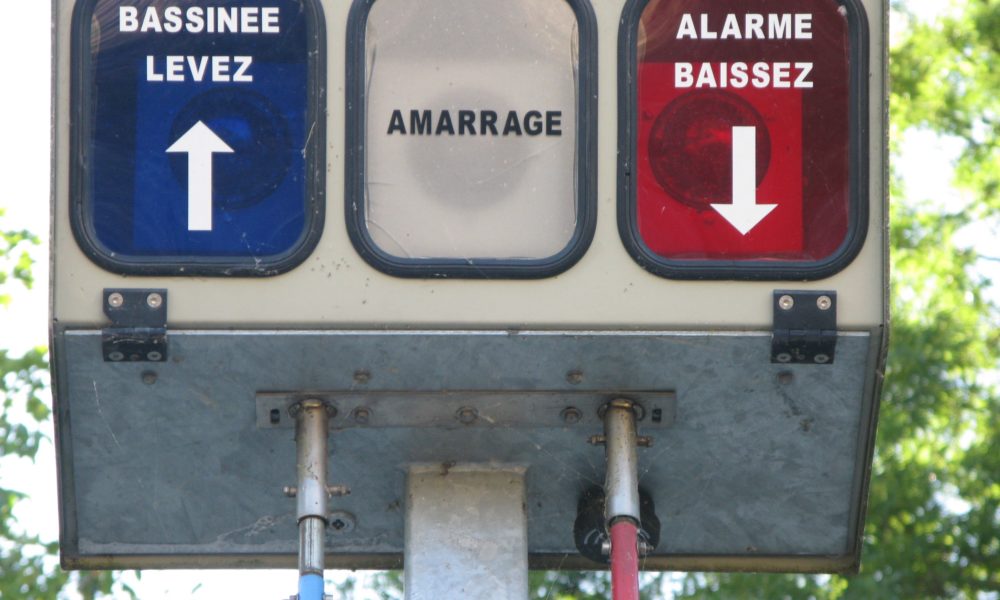
Hey! 24 locks in one day…
47° 41′ 2.2524” N 5° 20′ 41.3196” E
July 14, 2015
Effective day. And pretty exhausting. We have agreed with our neighbours from Bruges in Belgium, that we will break up with them as the first of four boats, and that we follow them through the locks. Their boat, Eva, is a broad-obsessed lady, totally strapped into a corset by huge fenders all around. They offer to go first into the locks. We say yes.
The day is laborious. Lock in and lock out. Some locks on this stretch are operated by young students ,who whiz off on their mopeds to make the locks ready for us. Others – the majority – are automated and controlled with the remote control, we have been given. Today’s highlight – literally – is a voyage through a nearly five-kilometre tunnel drilled through the mountain top. Dark, damp, clammy. Water drips onto our heads. The lighting is low, just enough that we can see to keep us in the channel. We keep a flashlight in reserve.
Our start in this tunnel, Balesmes sur-Marne, was governed in good bureaucratic French manner. A series of red and green lights in the tunnel ceiling are holding us back or invite us forward, depending on whether we are sailing too fast or too slowly. Circumstantially and annoyingly engineer-like. One senses that someone sits in a central office and plays with us.
The lock is a turning point. Since the beginning of Canal entre Champagne et Bourgogne, we have only been sailing upwards. 71 locks in total. 340 meters, we have been lifted since the channel start. From now on it is downhill. Right down to the Mediterranean, we think.
We use the first locks after the tunnel to get used to going down. It is said that this is much easier. More gentle to the ship and crew. For us, it is necessary however to catch the technique. In the first locks, we use the same technique, as when we locks up. Two hawsers. One for each, close to each other. It gives a sense of control when it goes up.
But going down there is not as much pressure from floodwaters in the lock chamber. The water disappears quietly under the boat. It is much calmer, and we become comfortable with simply having a single rope to the land, while we are experimenting with making as few moves as possible and let the boat take care of itself. A single puff with a boat hook or a single jerk in the hawser is enough. Yes, obviously it is easier to lock down than up. If it were not for the sun and heat, it would be pure relaxation.
We say goodbye to the Belgians after having sailed with them through 20 locks. Although we are taking additional four locks to Dommarien, which according to the map is a berth with 1.80 meters depth for two boats. It is not.
We hit the ground long before, we reach the quayside.
Instead we sail to the right side of the canal, where a converted peniche populated with young French people is located at the brink. We ask if we can moor side by side with them. No. They ask us to find another place. Rather unheard of. Sailors always give each other space. But they are probably landlubbers. Not sailors. Kirsten, frustrated, calls all sorts of curses upon the young landlubbers.
We must try again on the berth assigned in the chart. Nope. It is impossible. We cannot reach the shore. There continues to be one to one and a half meters between Ronja and the brink. We choose to make the boat stuck on this distance of the brink with the assistance of a helpful Frenchman. Well, anyway it does not seem temptating at all to go ashore, so we do not.
The helpful Frenchman seems to be new to sailing life. He has a small motorboat, which he has connected to the shore with three ropes and an anchor, which he has fixed on top of a little metal-bridge. We have never seen this before.
We celebrate with champagne today, the impressive distance and the fact that we have passed the peak and that the next few weeks of sailing goes down towards Saone, Rhone and the Mediterranean. A clear turning point.
Log book: Today’s distance: 35 km. Sailed time 8:45 to 19:15 = 10 ½ hour. Locks: 24 !!!! Weather: Sun all day. Light breeze made sure to dampen the unit. In these waters, the wind has only one meaning: To cool. To the navigation it has virtually no impact.
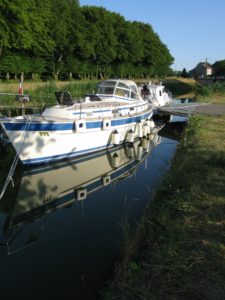
Sometimes you have to improvise finding mooring for Ronja
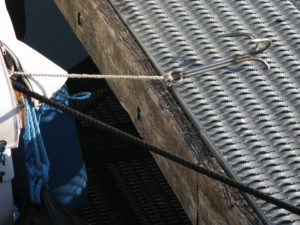
Not alle french sailors are trained in the craft of mooring. Her is a peculiar use of an anchor
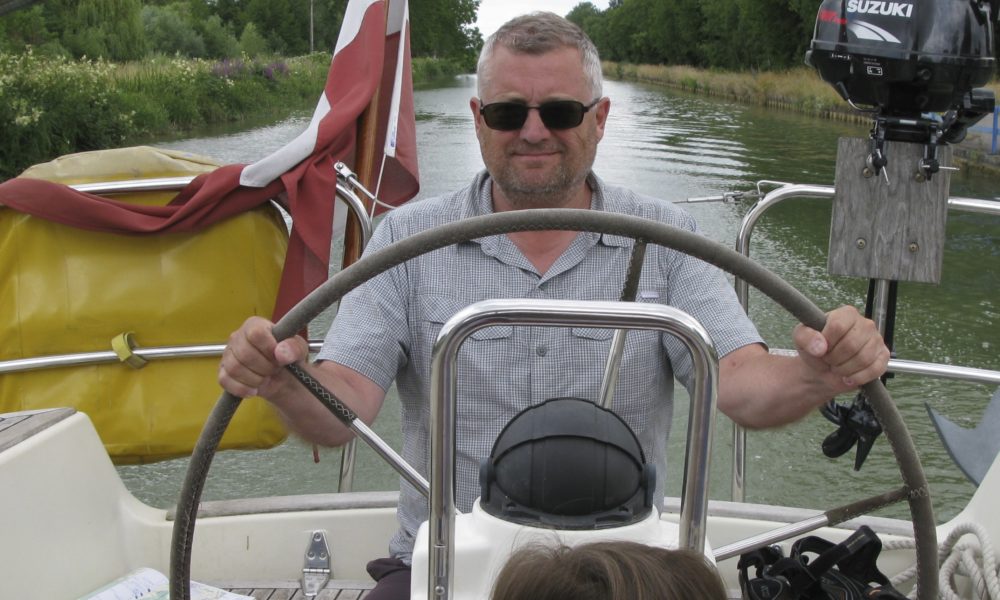
The lock system and almighty VNF sets the speed. Not you…
48° 18′ 1.7748” N 5° 8′ 48.9516” E
July 13, 2015
We say goodbye to Lasse, Tianling and Nellie. They want to go to Alsace, Germany and Denmark to find the wildest playground for Nellie. Instead of making departing into something sad, Lasse told Nellie that they now will start a hunt for a wild playground, and this project she is very pleased about. In today’s first lock they stand and wait and surprise us with an extra goodbye.
It requires patience to sail the French channels. The channel is in control. The lock system and the almighty VNF decide. Not you. Others set the pace.
You may be very much accustomed to the ways things are done back home on the job. You make things happen. Putting things off. Monitor progress. Intervene and speed up if a project loses momentum. On the canal is different.
The locks are based on a centuries-old system, which in recent years has been partially automated, but which are nevertheless based on the same routines and procedures. First notify your lock – via VHF radio, via a mechanical turn on a hanging rod or via a remote control – that you want to get through the gate. Then the lock reports back, that it has received your message, and it will start working on it. After some time – it can feel like a very long time – closes the farthest gate, and the emptying or filling of water begins. It takes time.
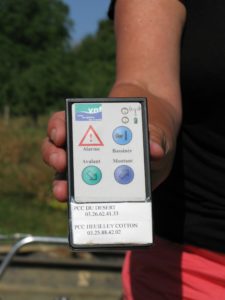
Remote control for operating the modernised locks. All is in french. But anyway the system is simple
From your position you can see the water gushing out, or – if you are on the decline – pouring into the lock chamber. When the water in the lock chamber has reached the same height as your part of the channel, which takes quite a while, a beep will sound and a flashing light shows, that now starts next stage in the process. The lock opens the lock chamber. It goes slowly. Very slowly. With high probability is this slowness carefully thought of some engineering minds, who wanted to avoid accidental rapid movements. Slowly, slowly, the front gate goes up. You can go in and find your place in the chamber.
Here begins the next phase. You give the lock a message via a mechanical lift on a blue rod or with the borrowed remote. You want to have the lock emptied or filled with water. It thinks a little about this. Often you may provide an additional signal. Again, the system is put together, so it makes quiet movements, time for reflection, time to get out of the way, no panic, in french: “lentement, lentement…”
There are those, who will argue, that it is healthy for the average busy person. Well there are even those who would argue, that this enforced tardiness is the very idea of a sailing holiday. Here you will be subjected to nature and other forces greater than yourself. Here you must adapt your thinking and your pace to others. Down to speed. Accept that others set the pace.
We are not angels. But perhaps it is still part of what we call the holiday, to be forced into a very slow pace.
Log book: Today’s distance: 29 km. Sailed time 9:30 to 16:00 = 6 ½ hours. Locks: 15 pcs. Weather: Perhaps the best sailing weather we had. Slightly overcast skies. Warm without being oppressive.
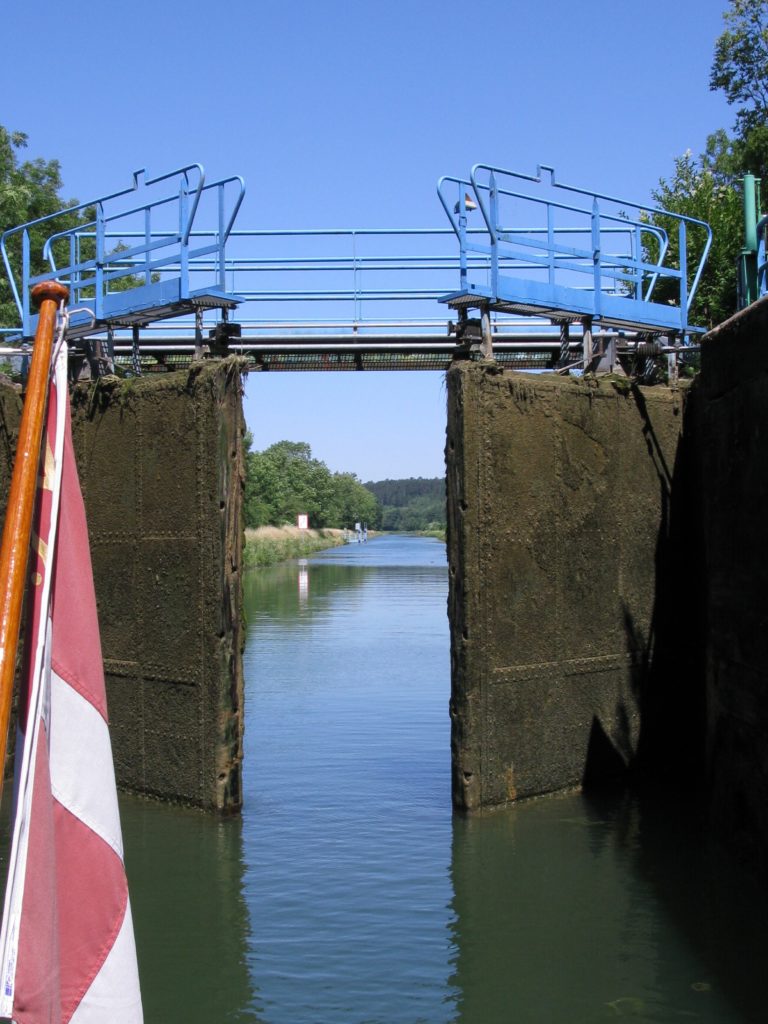
Locks forces you to go down in speed. Everything takes place in slowmotion. Probably good for something. Stress, maybe?
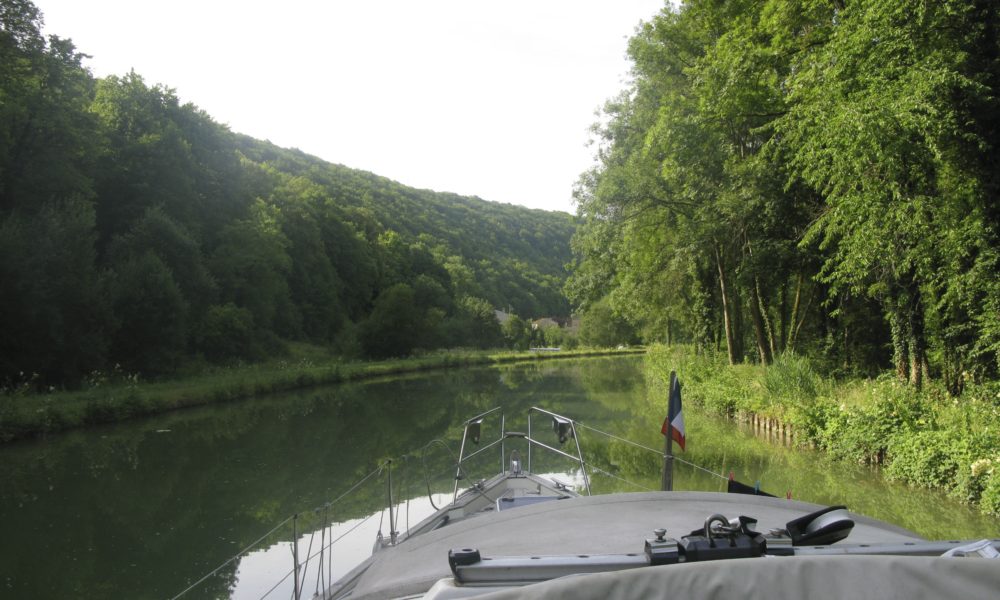
Sailing in the midst of the most beautiful nature
48° 6′ 49.4928” N 5° 8′ 21.3216” E
July 11, 2015
Two pieces of cake wrapped in tin foil is the farewell gift from the nice Brits, who will stay for another 10 days, because they are watching a dog for a friend. “We usually give the cakes to lock keepers,” they say. We ask if they are sailing all year. No, no. “The winter we spend in Spain. Only in the summer we sail in France “.
Today’s retirees have many ways of organizing their lives. Previously, we have spoken a few times with a Dutch couple, who no longer had a permanent in the Netherlands, but in the summer months sailed on the canals of Europe and in the winter lived in their apartment in Cape Town, South Africa.
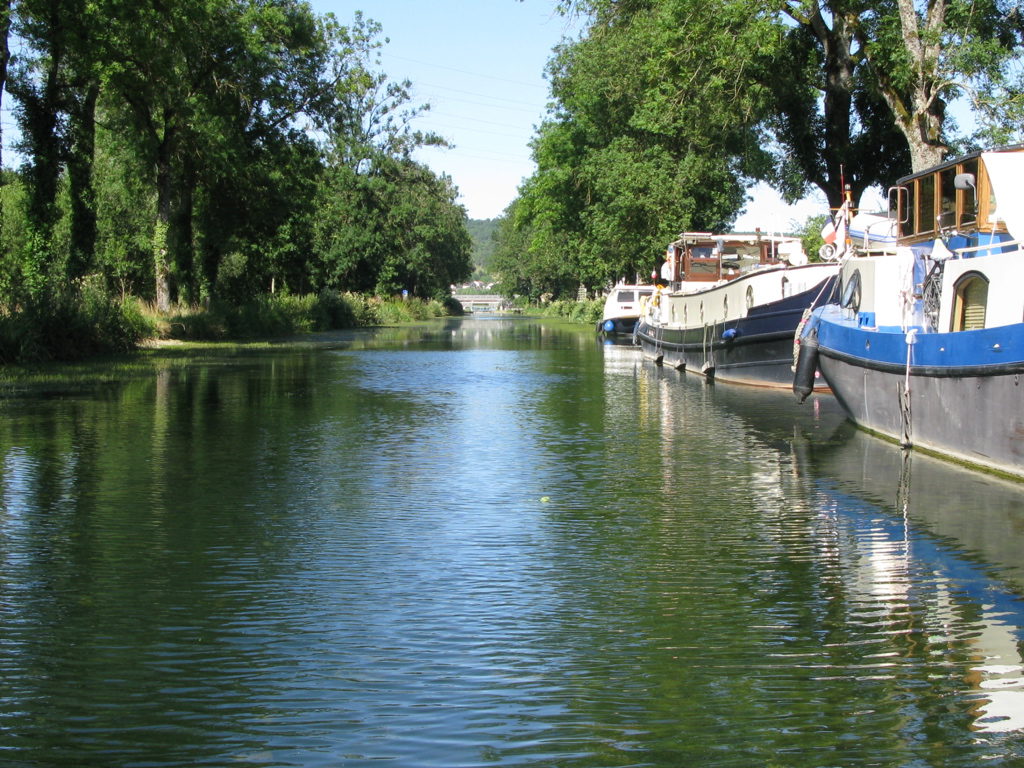
Marvellous mooring side by side with british vessels rebuild from business to leisure, spacey and modern
The ride is beautiful. The canal is curving through the landscape. Completely different from the straight channel-stretch, we have been accustomed to. Beautiful hills, rolling cornfields and lots of flowers close to the canal. The intense nature close to us is the big attraction of sailing on a canal. The banks made up of a tangle of flowers – climbing plants, thistles and many others – with purple, yellow and white as the predominant colours. A paradise for insects and birds. Dragonflies play tag. Venom spider webs are evident in the early morning hours and above us eagles are flying.
The only snake in paradise is the green sea cucumbers, which at long distances reduce our speed to less than two knots, because the keel plods through the wild growing of underwater plants. Periodically we put the engine in reverse to free the propeller of plant residues.
Lasse is driving in advance with the “follow car”, which is parked at a small jetty in Froncles. Five boats and five campers around a small piece of grass with electricity and toilets. It is fairly standard for a port in these parts. After having parked the car, he runs 14 to 15 kilometres back and meets us in a lock. Tianling jumps also gets of the boat on the way to take a walk.
It’s great to have Nellie on board. She is three and a half years old, and she is quickly settled on the boat. The large living cabin in the middle is hers. Here she is playing with clay, Legos and drawing. Here she sleeps at night. Quickly she finds out how to move around in the cockpit. Only once it goes wrong. She fell and hit her head against the rudder stock, but a heron flies over at the same time. “Look, Nellie, your happiness heron. It will see if you are seriously injured, and now flies further. ”
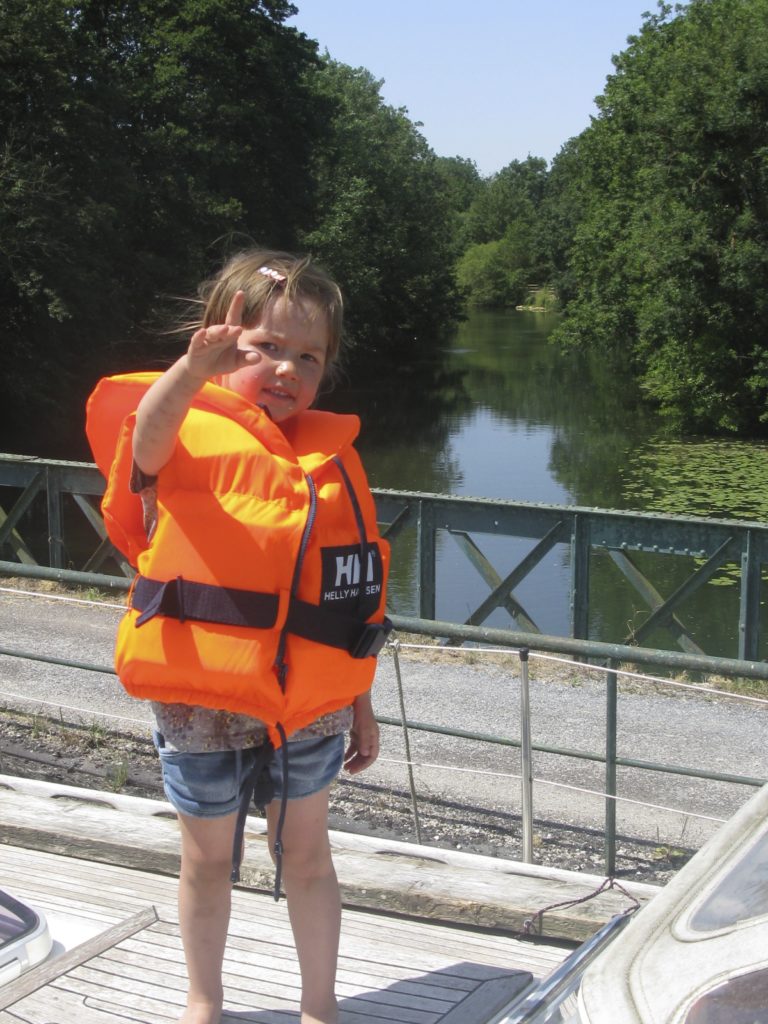
Grandchild Nellie wears lifejacket whenever close to the water
The hardest part for Nellie is the limits that naturally must be on a ship. In the cabin and cockpit, she must be without a lifejacket. But up on the deck and along the quay in the port she must always have a life jacket. After some border dispute on this, it is accepted as one of the terms of sailing life.
Log book: Today’s distance: 24 km. Sailed time 9:30 to 15:30 = 6 hours. Locks: 9 pcs. Weather: Warm, sultry, sun.
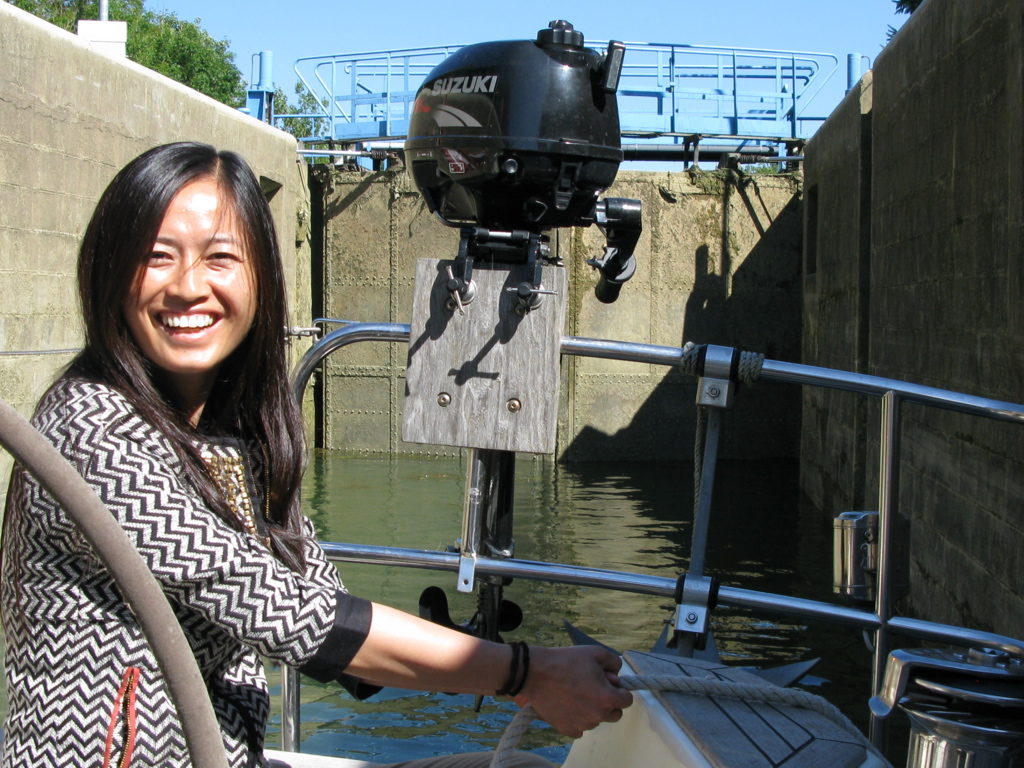
Tianling improves every day in her relatively new role as mate onboard Ronja
Help, we are under attack by green sea-sausages!
48° 37′ 1.4928” N 4° 57′ 1.3216” E
July 10. – 2015
Fresh bread. Fresh water on the tanks. New starting battery for Ronja. We are ready for a new day. Lasse drives the car to Joinville and park it, at what we assume to be our next stop. It is not. More about this later.
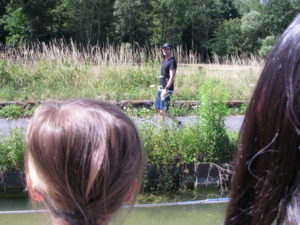
In turns we take a walking- or jogging-tour along the river. The sailing here is a bit boring, so any kind of variation is wellcomed
Lasse will run to meet us from Joinville, 24 kilometres further down the canal. He manages to run 17 kilometres, before we have him on board again.
A full day of sailing. Most locks are ready, when we come to them. Only problem is a wild, green sausage-like plant that causes the sonar to signal constant danger – 0.0 meters below the keel – and which slows us down to something like 50 percent.
We are sailing through an underwater jungle of thick, spruce-like plants that spread out from the shore and appear to be in the process of conquering the entire channel. Only in a small stream in the middle, we can fight our way forward. Regularly we had to put Ronja at full speed astern, then full speed ahead. This will free us from the most aggressive of the green sea sausages. If the French do not find out how to keep these growths down, it may close the channel-tourism in a few years.
All this coming and going. Shortly after Lasse boarded after his run, Kirsten buckles her sandals to go ahead and explore the possibilities for accommodation by walking along the canal. While we struggle our way with only two knots between the aggressive aquatic plants, Kirsten talks to people along the canal and with captains of a few peniches.
Do not stay in Joinville, they say. It’s expensive, and it’s boring. They have found a place one kilometre before Joinville. The site is located “in the middle of nowhere” with a view of fields and forests. The facilities consist of a bench. No electricity. No water. No waste containers. In return frogs croak and the channel beckons with coolness and fish, so many that a three year old can capture them with a fishing-net.
The channel is not deep enough for us to get right to the shore, so we attach ourselves to the outside of a British couple, who have been here a long time and will be here for another 10 days. Together with them we block almost the entire channel. “There will be no more boats today. We have been away all year, and there are almost no boats. We have yet to see a commercial ship in the channel, ” the brits say from their peniche with oven and air conditioning. They point in one direction: Restaurant. They point in the another direction: Supermarket. Here we have everything. The rest is incredibly beautiful scenery.
We cannot help but wonder, how the french waterways are organised. Today we had two VNF employees following us at half the trip. On their mopeds they have followed us from lock to lock, from automated bridge to automated bridge. What job they have made, is hard to sy. They have not touched a hand. Just followed our movements from a distance.
One thinks involuntarily, though it might have been better to let the locks staffed, for it seems to us, that they use the same amount of labour, now that the locks are automated.
They should use resources to keep the channels dredged and free of green “sea sausages”. Instead it seems as if they let all indulge in an unrestrained consumption of labour. Anyway: We are in France.
We eat at the restaurant a few meters from the quayside. Excellent.
Log book: Today’s distance: 23 km. Sailed time from 10.00 to 15.30 = 5 ½ hours. Locks: 10. Weather: Sun all day. No heatwave. Just hot. Such as a summer in France should be. We stopped to check the weather, so we know nothing about current or future weather conditions. Channel sailing is not as dependent on the weather as ocean navigation.
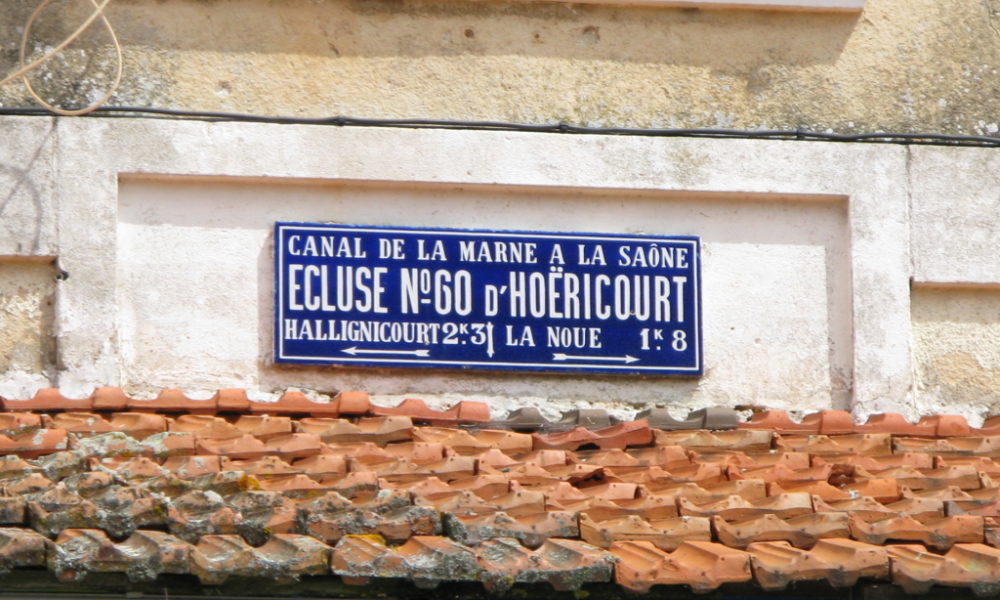
All signposts are in french. All sailors are non-french
48° 43′ 33.9132” N 4° 35′ 8.682” E
Wednesday – July 8, 2016
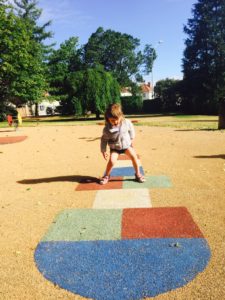
Playing in Vitry-le-Francois
Up early to go in and experience Vitry-le-Francois. We start with the playground at the town hall. Swings, slides and hopscotch. Simple but just what Nellie wants. As we pass the open windows of the town hall – a magnificent piece of classical mansion – we see that in several offices are typewriters. These analog, old-fashioned, mechanical appliances from the previous century. We also see computer screens. Anyway, typewriters in 2015? Sigh.
We eat croissant and drink coffee at a cafe. We buy Lego Friends, and we buy a long-sleeved shirt to protect Nellie against mosquito bites, and as a precaution also buy additional children’s patches, as they has been shown to have a strong psychological effect on itchy mosquito-bites. Especially those patches that have airplanes on them.
We break up at 2 p.m. There is pretty much wind. But we are a sailing boat, created for the roaring oceans. We say goodbye to our American neighbours and wish them good luck with their transmission shaft. In some way we sense that our own story with a broken shaft and many months of traumatic trouble with the French mechanics did not reassure them. Sometimes you have to just leave them to their own experience, even if you have experienced similar.
Now for the Canal entre Champagne et Bourgogne. 224 km with 114 locks and a nearly five-kilometre long tunnel along the way. It was formerly called the channel “Canal entre Marne et Saone” but one bright person at a tourist office probably got the idea to rename the channel to something with champagne and burgundy, so now it is called so – although Vitry has no more champagne-growing, and at the other end there are no single burgundy-fields. It is stagnant peasant country. Cereals and cows.
The French are not consistent. The old name, “Canal entre Marne a Saone” still occur on most signs along the canal – signs that are one hundred percent written in French. All information. All instructions. All brochures on the channel. Everything is in French. Only French. Stupid.
The French would not dream of sailing on the canals themselves. Well, except for one or two. It is Americans, Australians, British, Germans, Belgians and especially Dutch sailors that man the French rivers and channels in a fleet of converted barges, custom-built riverboats, lavish motored and castrated sailboats – including one from Denmark. We meet – virtually – no sailors from France.
Would it then make sense to make signs communicating in English or German? Yes, by God. But the French would not dream of it.
We sail to Orconte and stop at a stump berth surrounded by cornfields, trees, anglers and bird song. The only other boat at the dock are our friends from the UK, a young couple – on leave with their two children. Nice, Nellie is among friends and spends the evening with Bertie and Elisa.
Log-book: Today’s distance: 14 km. Sailed time 14.00 to 17.30 = 3 ½ hours. Locks: 6 pcs. Weather: autom-like. We woke up to the leaves falling from the trees. The wind is cold. The sky is grey. The heat wave is blown away. Back to normal?
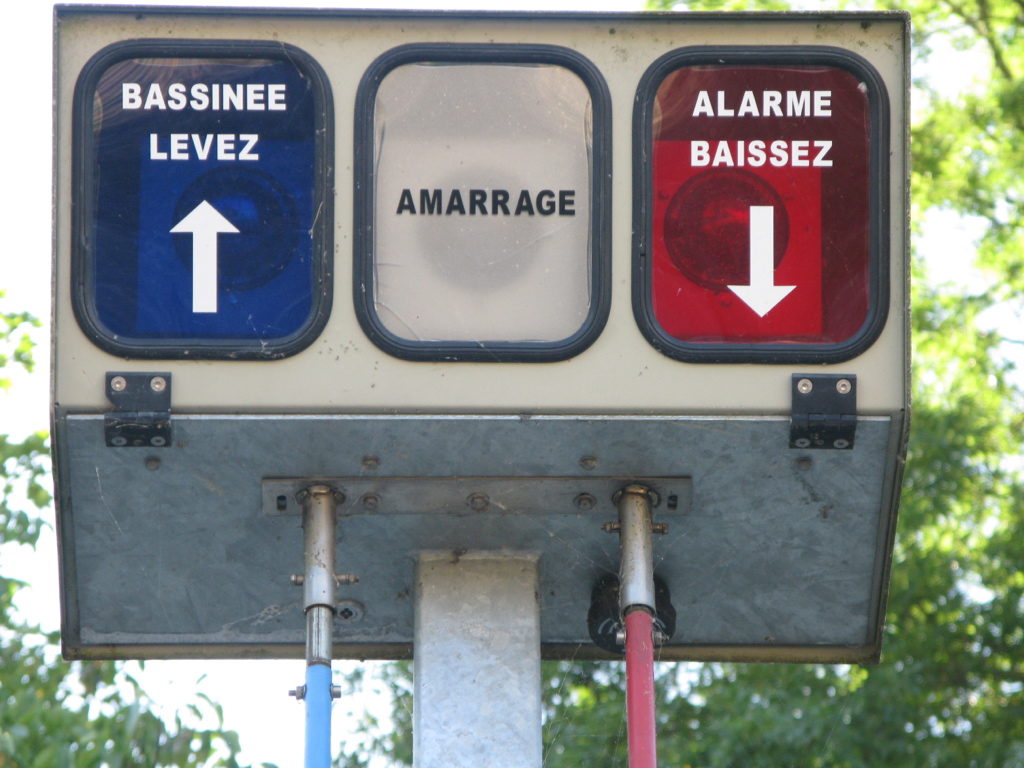
Would it help, if signposts were in english? Yes, because all sailors in the french rivers and canals are non-french
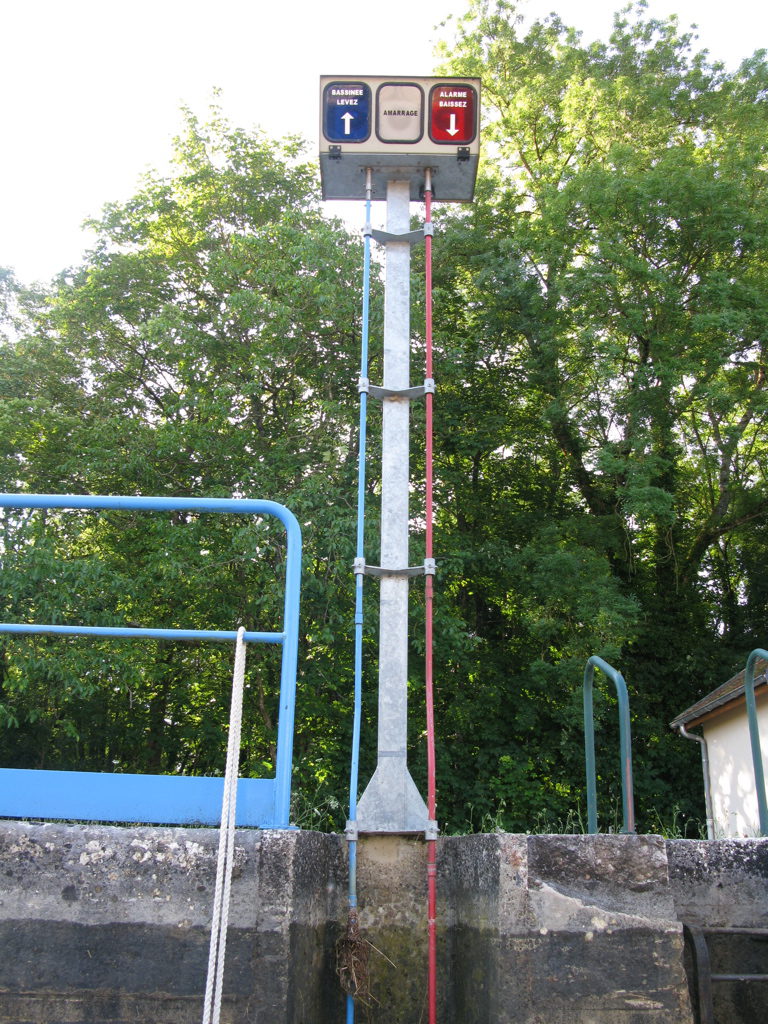
Mechanical lock. Pull up the blue tube, and the lock starts operating